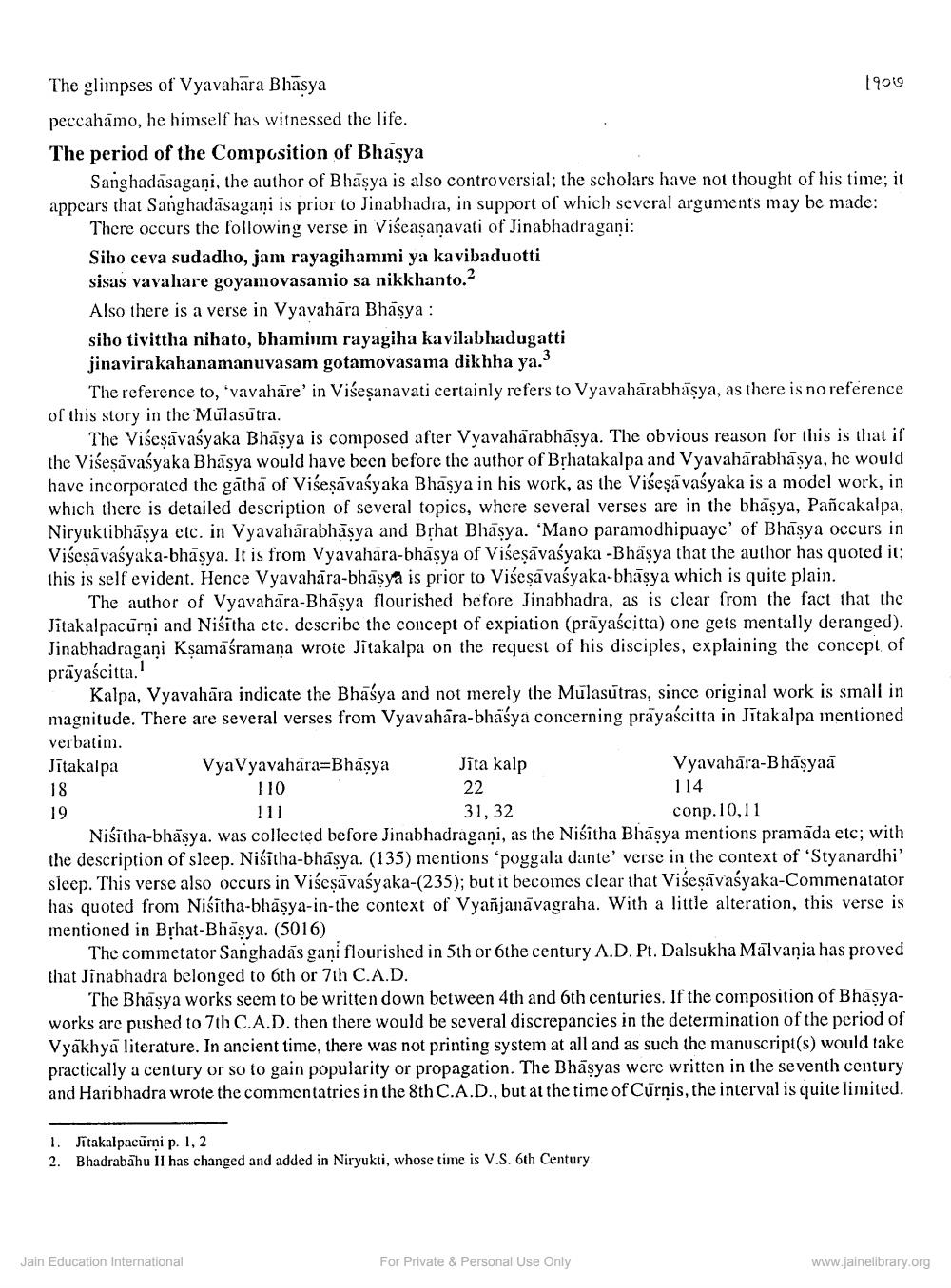________________
The glimpses of Vyavahara Bhāsya
1900 peccahāmo, he himself has witnessed the life. The period of the Composition of Bhasya
Sanghadasagani, the author of Bhasya is also controversial; the scholars have not thought of his time; it appears that Sanghadasagani is prior to Jinabhadra, in support of which several arguments may be made:
There occurs the following verse in Viseasanavati of Jinabhadragani: Siho ceva sudadho, jam rayagihammi ya ka vibaduotti sisas vavahare goyamovasamio sa nikkhanto.2 Also there is a verse in Vyavahāra Bhasya : sibo tivittha nihato, bhamium rayagiha ka vilabhadugatti jinavirakahanamanuvasam gotamovasama dikhha ya."
The reference to, 'vavahāre' in Višeşanavati certainly refers to Vyavahārabhasya, as there is no reference of this story in the Mülasutra.
The Viścsavasyaka Bhasya is composed after Vyavaharabhāsya. The obvious reason for this is that if the Visesavasyaka Bhasya would have been before the author of Bịhatakalpa and Vyavahārabhāsya, he would have incorporated the gathā of Visesavaśyaka Bhasya in his work, as the Višeşā vaśyaka is a model work, in which there is detailed description of several topics, where several verses are in the bhasya, Pañcakalpa, Niryuktibhasya etc. in Vyavahārabhāsya and Brhat Bhasya. 'Mano paramodhipuaye' of Bhāsya occurs in Visesavaśyaka-bhasya. It is from Vyavahāra-bhasya of Visesavaśyaka - Bhasya that the author has quoted it; this is self evident. Hence Vyavahāra-bhāsya is prior to Višeşāvaśyaka-bhasya which is quite plain.
The author of Vyavahāra-Bhasya flourished before Jinabhadra, as is clear from the fact that the Jitakalpacūrņi and Niśitha etc. describe the concept of expiation (prāyaścitta) one gets mentally deranged). Jinabhadragani Kșamāśramana wrote Jitakalpa on the request of his disciples, explaining the concepi of prāyaścitta.!
Kalpa, Vyavahāra indicate the Bhasya and not merely the Mülasutras, since original work is small in magnitude. There are several verses from Vyavahara-bhasya concerning prayascitta in Jitakalpa mentioned verbatin. Jitakalpa VyaVyavahāra=Bhasya Jīta kalp
Vyavahāra-Bhasyaā 18 110
22 111 31, 32
conp. 10,11 Nisītha-bhäsya. was collected before Jinabhadragani, as the Niśitha Bhasya mentions pramada etc; with the description of sleep. Niśitha-bhasya. (135) mentions 'poggala dante' verse in the context of 'Styanardhi' sleep. This verse also occurs in Višeşāvaśyaka-(235); but it becomes clear that Višeşāvaśyaka-Commenatator has quoted from Niśitha-bhasya-in-the context of Vyañjanavagraha. With a little alteration, this verse is mentioned in Bệhat-Bhasya. (5016)
The commetator Sanghadās gani flourished in 5th or 6the century A.D. Pt. Dalsukha Malvania has proved that Jinabhadra belonged to 6th or 7th C.A.D.
The Bhasya works seem to be written down between 4th and 6th centuries. If the composition of Bhasyaworks are pushed to 7th C.A.D. then there would be several discrepancies in the determination of the period of Vyakhyā literature. In ancient time, there was not printing system at all and as such the manuscript(s) would take practically a century or so to gain popularity or propagation. The Bhāşyas were written in the seventh century and Haribhadra wrote the commentatries in the 8th C.A.D., but at the time of Cūrnis, the interval is quite limited.
114
19
1. Jitakalpacūrni p. I, 2 2. Bhadrabahu 11 has changed and added in Niryukti, whose time is V.S. 6th Century,
Jain Education International
For Private & Personal Use Only
www.jainelibrary.org




